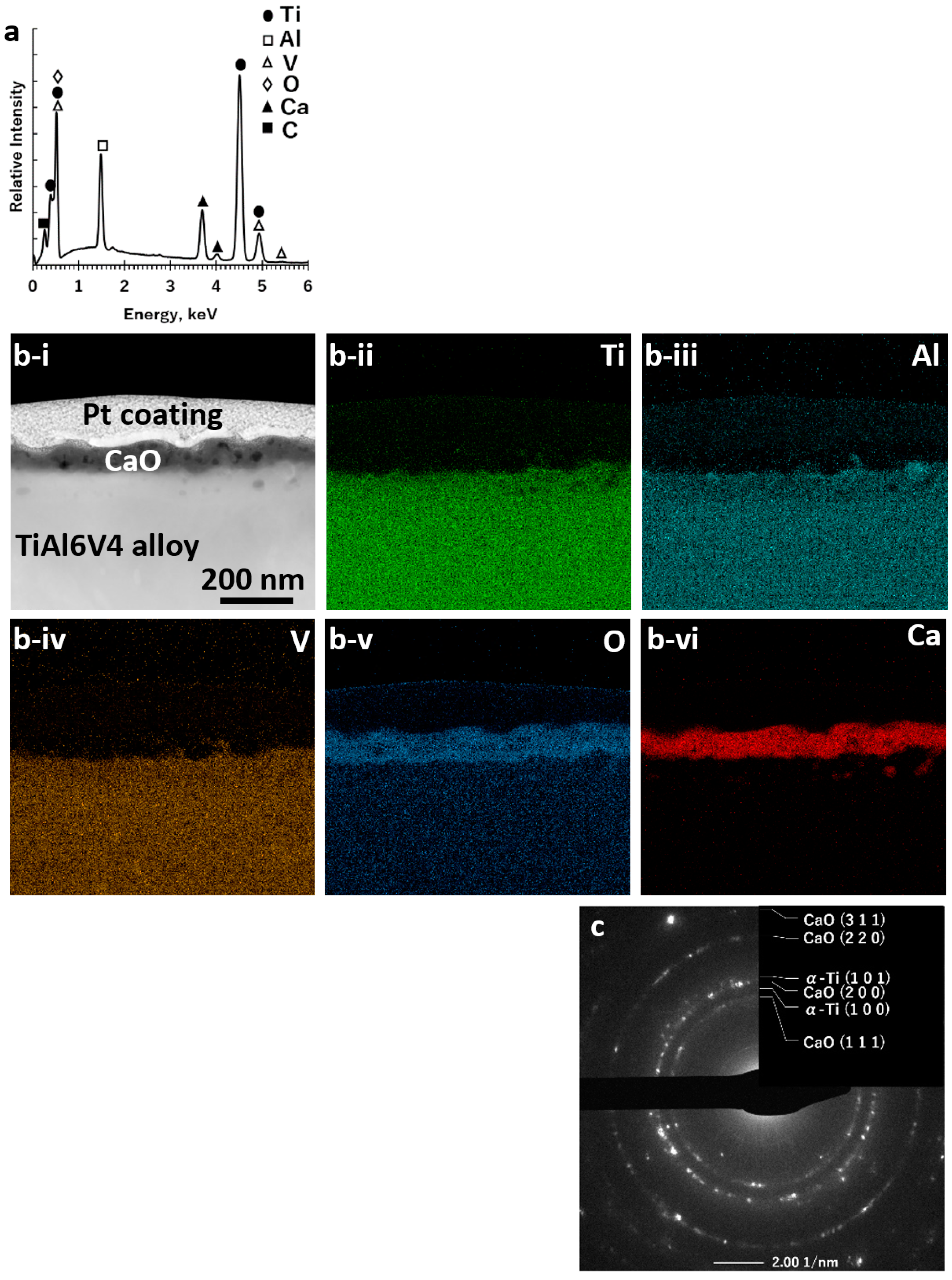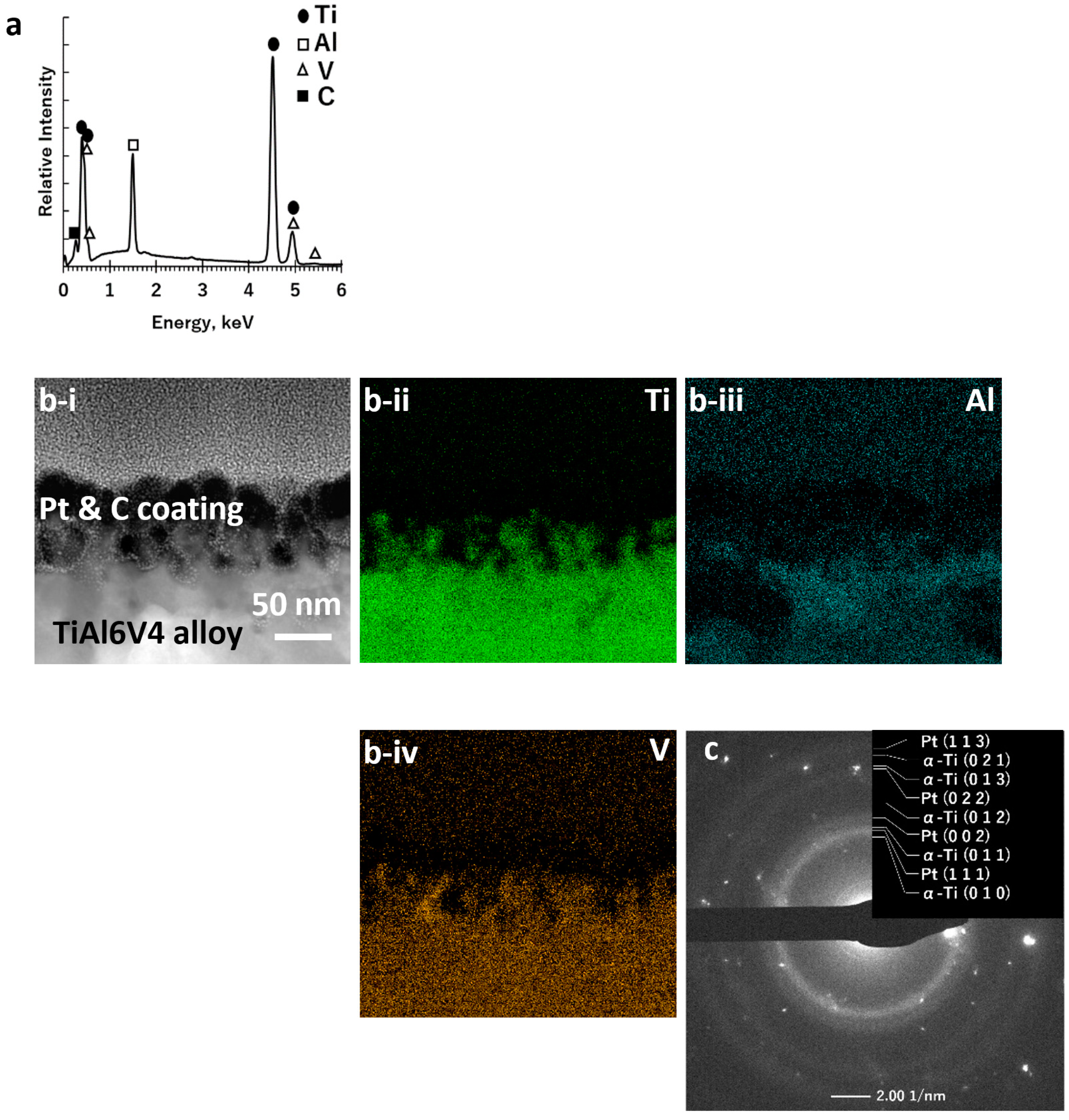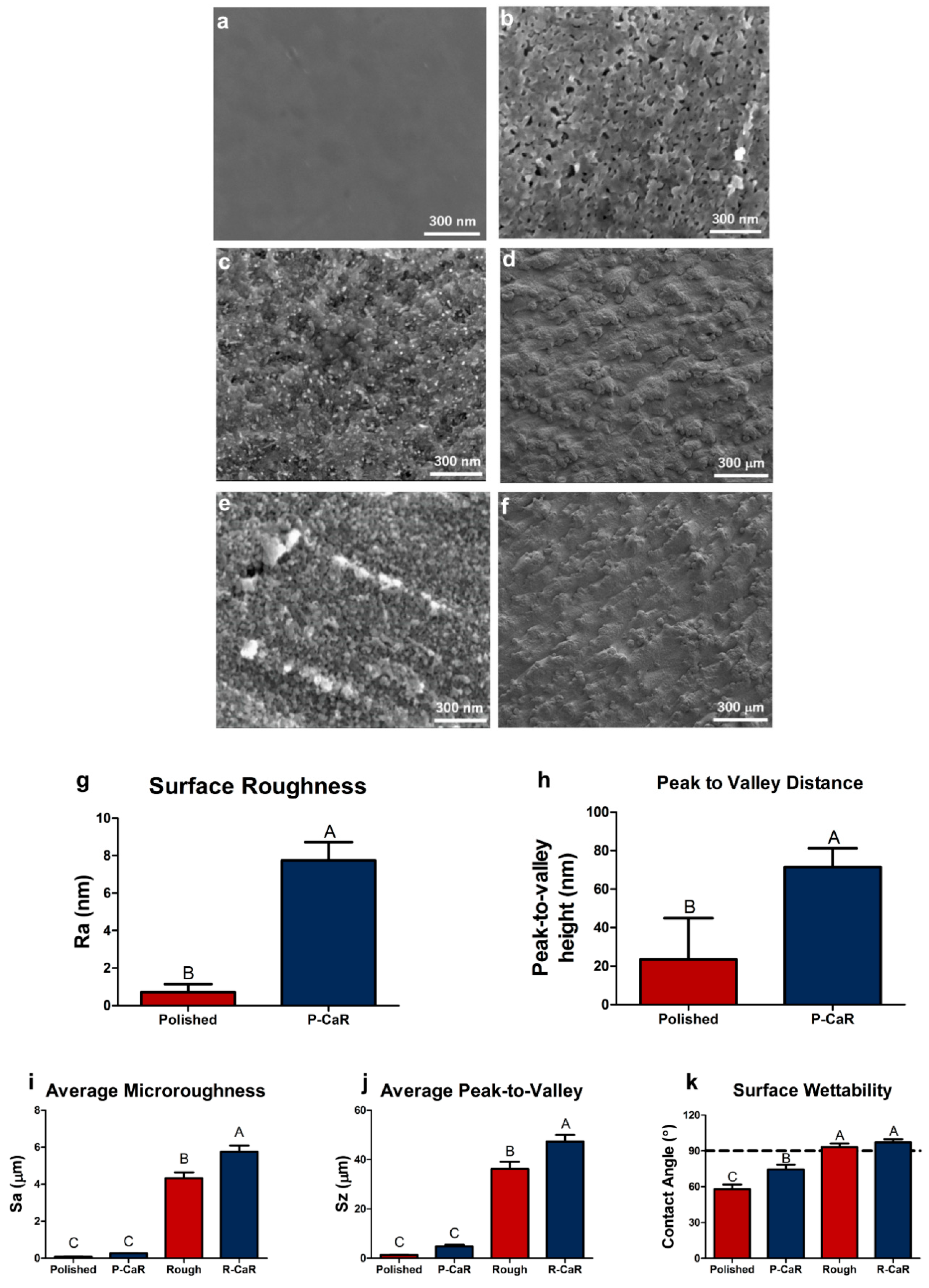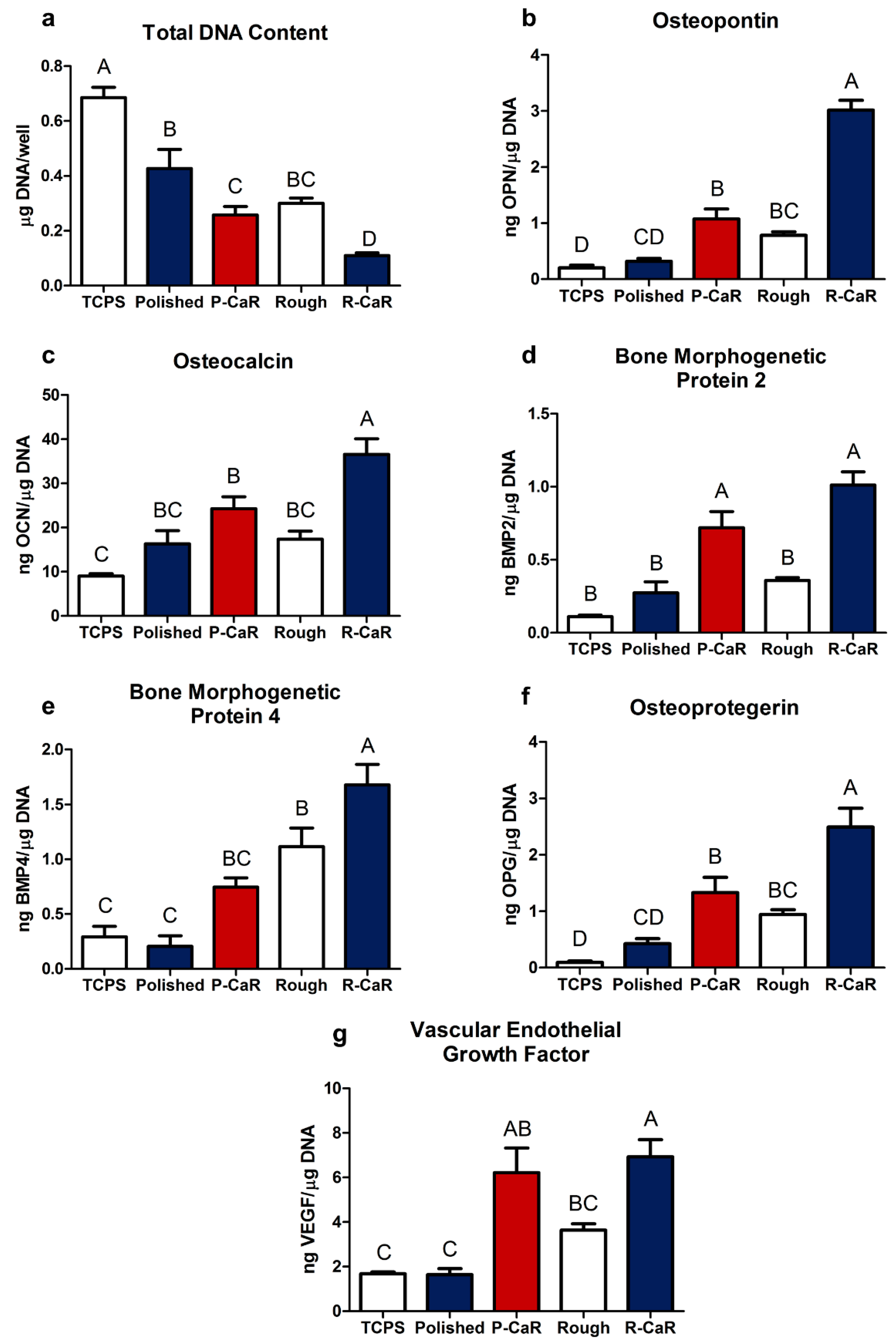Tailoring of TiAl6V4 Surface Nanostructure for Enhanced In Vitro Osteoblast Response via Gas/Solid (Non-Line-of-Sight) Oxidation/Reduction Reactions
Abstract
:1. Introduction
- (1)
- A modest thermal oxidation treatment in air to generate a thin (submicron), conformal, continuous TiO2-based surface layer of tailorable thickness on the TiAl6V4 alloy.
- (2)
- Selective reaction with Ca vapor for reduction of the TiO2 in the thin surface layer to yield a conformal, thin, nanoporous Ti-based layer, along with CaO.
- (3)
- Selective dissolution of the CaO product to yield a conformal, thin, nanoporous/nanorough Ti-based surface layer bonded to the underlying dense TiAl6V4 alloy.
2. Materials and Methods
2.1. Titanium Alloy Substrate Preparation
2.2. Oxidation, Calciothermic Reaction, and Oxide Dissolution
- (i)
- Exposure to air at 600 °C for 6 h to generate a continuous, conformal, nanocrystalline rutile TiO2-based surface layer on the TiAl6V4 surface (Figure 1a,b).
- (ii)
- Reaction of the TiO2-based layer with Ca(g) at 700 °C for 1 h to generate CaO and Ti-rich products (Figure 1c).
- (iii)
- Exposure to a 3 M acetic acid solution for 40 min at 25 °C to selectively dissolve the CaO reaction product to yield a thin, porous, conformal Ti-rich surface layer (Figure 1d).
2.3. Surface Characterization
2.4. Cell Culture
2.5. Analyses of Cellular Responses
- (i)
- TiAl6V4 surfaces polished to a 0.05 μm finish (“polished“ specimens)
- (ii)
- TiAl6V4 surfaces exposed to grit blasting and acid etching (“rough“ specimens)
- (iii)
- Polished TiAl6V4 surfaces that had undergone the calciothermic reaction-based process (“P-CaR“ specimens).
- (iv)
- Grit-blasted/acid-etched (rough) TiAl6V4 surfaces that had undergone the reaction process (“R-CaR“ specimens)
2.6. Statisical Analyses
3. Results
3.1. Nanochemical Modification of the TiAl6V4 Surface
3.2. Nanostructural Modification of the TiAl6V4 Surface
3.3. Responses of MSCs to Reaction-Modified TiAl6V4 Surfaces
4. Discussion
4.1. Thermodynamic Considerations
4.2. Evolution of Surface Chemistry and Phase Content
4.3. Mechanism of Nanopore Formation on the TiAl6V4 Surface
4.4. Interactions of MSCs with Reaction-Modified Surfaces
5. Conclusions
6. Patent
Supplementary Materials
Author Contributions
Funding
Institutional Review Board Statement
Informed Consent Statement
Data Availability Statement
Acknowledgments
Conflicts of Interest
References
- Jackson, M.J.; Ahmed, W. Titanium and Titanium Alloy Applications. In Surface Engineered Surgical Tools and Medical Devices; Springer: New York, NY, USA, 2007; pp. 533–576. [Google Scholar]
- Geetha, M.; Singh, A.K.; Asokamani, R.; Gogia, A.K. Ti based biomaterials, The ultimate choice for orthopaedic implants—A review. Prog. Mater. Sci. 2019, 54, 397–425. [Google Scholar] [CrossRef]
- Van Noort, R. Titanium: The implant material of today. J. Mater. Sci. 1987, 22, 3801–3811. [Google Scholar] [CrossRef]
- Dalby, M.J.; Gadegaard, N.; Tare, R.; Andar, A.; Riehle, M.O.; Herzyk, P.; Wilkinson, C.D.W.; Oreffo, R.O.C. The control of human mesenchymal cell differentiation using nanoscale symmetry and disorder. Nat. Mater. 2007, 6, 997–1003. [Google Scholar] [CrossRef]
- Oh, S.; Brammer, K.S.; Li, Y.S.J.; Teng, D.; Engler, A.J.; Chien, S.; Jin, S. Stem cell fate dictated solely by altered nanotube dimension. Proc. Natl. Acad. Sci. USA 2009, 106, 2130–2133. [Google Scholar] [CrossRef]
- McMurray, R.J.; Gadegaard, N.; Tsimbouri, P.M.; Burgess, K.V.; McNamara, L.E.; Tare, R.; Murawski, K.; Kingham, E.; Oreffo, R.O.C.; Dalby, M.J. Nanoscale surfaces for the long-term maintenance of mesenchymal stem cell phenotype and multipotency. Nat. Mater. 2011, 10, 637–644. [Google Scholar] [CrossRef]
- Skoog, S.A.; Kumar, G.; Narayan, R.J.; Goering, P.L. Biological responses to immobilized microscale and nanoscale surface topographies. Pharmacol. Ther. 2018, 182, 33–55. [Google Scholar] [CrossRef]
- Turlybekuly, A.; Pogrebnjak, A.D.; Sukhodub, L.F.; Kistaubayeva, A.S.; Savitskaya, I.S.; Shokatayeva, D.H.; Bondar, O.V.; Shaimardanov, Z.K.; Plotnikov, S.V.; Shaimardanova, B.H.; et al. Synthesis, characterization, in-vitro biocompatibility and antibacterial properties study of nanocomposite materials based on hydroxyapatite-biphasic ZnO micro- and nanoparticles embedded in alginate matrix. Mater. Sci. Eng. C Mater. Biol. Appl. 2019, 104, 109965. [Google Scholar] [CrossRef]
- Rabiei, A.; Thomas, B.; Jin, C.; Narayan, R.; Cuomo, J.; Yang, Y.; Ong, J. A study on functionally graded HA coatings processed using ion beam assisted deposition with in situ heat treatment. Surf. Coat. Technol. 2006, 200, 6111–6116. [Google Scholar] [CrossRef]
- Das, A.; Chikkala, A.K.; Bharti, G.P.; Behera, R.R.; Mamilla, R.S.; Khare, A.; Dobbidi, P. Effect of thickness on optical and microwave dielectric properties of hydroxyapatite films deposited by RF magnetron sputtering. J. Alloys Compd. 2018, 739, 729–736. [Google Scholar] [CrossRef]
- Yang, Y.; Kim, K.-H.; Ong, J.L. A review on calcium phosphate coatings produced using a sputtering process—An alternative to plasma spraying. Biomaterials 2005, 26, 327–337. [Google Scholar] [CrossRef]
- Gligorijevic, B.R.; Vilotijevic, M.; Scepanovic, M.; Vidovic, D.; Radovic, N.A. Surface structural heterogeneity of high power plasma-sprayed hydroxyapatite coatings. J. Alloys Compd. 2016, 687, 421–430. [Google Scholar] [CrossRef]
- Behera, R.R.; Das, A.; Hasan, A.; Pamu, D.; Pandey, L.M.; Sankar, M.R. Deposition of biphasic calcium phosphate film on laser surface textured Tie6Ale4V and its effect on different biological properties for orthopedic applications. J. Alloys Comp. 2020, 842, 155683. [Google Scholar] [CrossRef]
- Behera, R.R.; Hasan, A.; Sankar, M.R.; Pandey, L.M. Laser cladding with HA and functionally graded TiO2-HA precursors on Ti–6Al–4V alloy for enhancing bioactivity and cyto-compatibility. Surface Coat. Technol. 2018, 352, 420–436. [Google Scholar] [CrossRef]
- Hasan, A.; Pandey, L.M. Surface modification of Ti6Al4V by forming hybrid self-assembled monolayers and its effect on collagen-I adsorption, osteoblast adhesion and integrin expression. Appl. Surf. Sci. 2020, 505, 144611. [Google Scholar] [CrossRef]
- Gittens, R.A.; McLachlan, T.; Olivares-Navarrete, R.; Cai, Y.; Berner, S.; Tannenbaum, R.; Schwartz, Z.; Sandhage, K.H.; Boyan, B.D. The effects of combined micron-/submicron-scale surface roughness and nanoscale features on cell proliferation and differentiation. Biomaterials 2011, 32, 3395–3403. [Google Scholar] [CrossRef]
- Jang, T.-S.; Jung, H.-D.; Kim, S.; Moon, B.S.; Baek, J.; Park, C.; Song, J.; Kim, H.E. Multiscale porous titanium surfaces via a two-step etching process for improved mechanical and biological performance. Biomed. Mater. 2017, 12, 25008/1. [Google Scholar] [CrossRef]
- Cheng, A.; Humayun, A.; Cohen, D.J.; Boyan, B.D.; Schwartz, Z. Additively manufactured 3D porous Ti-6Al-4V constructs mimic trabecular bone structure and regulate osteoblast proliferation, differentiation and local factor production in a porosity and surface roughness dependent manner. Biofabrication 2014, 6, 045007. [Google Scholar] [CrossRef]
- Cohen, D.J.; Cheng, A.; Kahn, A.; Aviram, M.; Whitehead, A.J.; Hyzy, S.L.; Clohessy, R.M.; Boyan, B.D.; Schwartz, Z. Novel osteogenic Ti-6Al-4V device for restoration of dental function in patients with large bone deficiencies: Design, development and implementation. Sci. Rep. 2016, 6, 20493. [Google Scholar] [CrossRef]
- Butscher, A.; Bohner, M.; Hofmann, S.; Gauckler, L.; Müller, R. Structural and material approaches to bone tissue engineering in powder-based three-dimensional printing. Acta Biomater. 2011, 7, 907–920. [Google Scholar] [CrossRef]
- Leordean, D.; Radu, S.A.; Frătilă, D.; Berce, P. Studies on design of customized orthopedic endoprostheses of titanium alloy manufactured by SLM. Int. J. Adv. Manuf. Technol. 2015, 79, 905–920. [Google Scholar] [CrossRef]
- Nyberg, E.L.; Farris, A.L.; Hung, B.P.; Dias, M.; Grayson, W.L.; Garcia, J.R.; Dorafshar, A.H.; Grayson, W.L. 3D-printing technologies for craniofacial rehabilitation, reconstruction, and regeneration. Ann. Biomed. Eng. 2017, 45, 45–57. [Google Scholar] [CrossRef] [PubMed]
- Sandhage, K.H.; de Glee, B.M. Methods for Forming Microscale and/or Nanoscale Structures on Surfaces and Devices Including Biomedical Devices Having Surfaces with Such Structures. International Patent Application No. PCT/US2021/035723, WO2021247879A1, 3 June 2021. [Google Scholar]
- ISO 13485:2016; Medical Devices—Quality Management Systems—Requirements for Regulatory Purposes. International Organization for Standardization (ISO): Geneva, Switzerland, 2020.
- Casadebaigt, A.; Hugues, J.; Monceau, D. High temperature oxidation and embrittlement at 500–600 °C of Ti-6Al-4V alloy fabricated by laser and electron beam melting. Corr. Sci. 2020, 175, 108875. [Google Scholar] [CrossRef]
- Hayes, W.M.; Lide, D.R. Handbook of Chemistry and Physics; CRC Press: New York, NY, USA, 2011; pp. 4–55. [Google Scholar]
- Jandt, K.D. Atomic force microscopy of biomaterials surfaces and interfaces. Surf. Sci. 2001, 491, 303–322. [Google Scholar] [CrossRef]
- Shotton, D.M. Confocal scanning optical microscopy and its applications for biological specimens. J. Cell Sci. 1989, 94, 175–206. [Google Scholar] [CrossRef]
- Lotz, E.M.; Berger, M.B.; Boyan, B.D.; Schwartz, Z. Regulation of mesenchymal stem cell differentiation on microstructured titanium surfaces by semaphorin 3A. Bone 2020, 134, 115260. [Google Scholar] [CrossRef]
- Raines, A.L.; Berger, M.B.; Schwartz, Z.; Boyan, B.D. Osteoblasts grown on microroughened titanium surfaces regulate angiogenic growth factor production through specific integrin receptors. Acta Biomater. 2019, 97, 578–586. [Google Scholar] [CrossRef]
- Zhao, G.; Zinger, O.; Schwartz, Z.; Wieland, M.; Landolt, D.; Boyan, B.D. Osteoblast-like cells are sensitive to submicron-scale surface structure. Clin. Oral Implant. Res. 2006, 17, 258–264. [Google Scholar] [CrossRef]
- Murray, J.L. Phase Diagrams of Binary Titanium Alloys; ASM International: Materials Park, OH, USA, 1987; pp. 52–53. [Google Scholar]
- Gourishankar, K.V.; Ranjbar, M.K.; St. Pierre, G.R. Revision of the enthalpies and Gibbs energies of formation of calcium oxide and magnesium oxide. J. Phase Equilibria 1993, 14, 601–611. [Google Scholar] [CrossRef]
- Barin, I. Thermochemical Data of Pure Substances, 3rd ed.; VCH Verlagsgesellshaft mbH: Weinheim, Germany, 1995; Volume 417, p. 1692. [Google Scholar]
- Kenel, C.; Kenel, C.; Li, X.; Leinenbach, C.; Grolimund, D.; Panepucci, E.; Samson, V.A.; Sanchez, D.F.; Marone, F. In situ investigation of phase transformations in Ti-6Al-4V under additive manufacturing conditions combining laser melting and high-speed micro-X-ray diffraction. Sci. Rep. 2017, 7, 16358. [Google Scholar] [CrossRef]
- Boyer, R.; Welsch, G.; Collings, E.W. Materials Properties Handbook: Titanium Alloys; ASM International: Materials Park, OH, USA, 1994; pp. 483–636. [Google Scholar]
- Trunov, M.A.; Schoenitz, M.; Dreizin, E.L. Effect of polymorphic phase transformations in alumina layer on ignition of aluminium particles. Combust. Theory Model. 2006, 10, 603–623. [Google Scholar] [CrossRef]
- Cullity, B.D. Elements of X-ray Diffraction, 2nd ed.; Addison-Wesley Publishing Company Inc.: Reading, MA, USA, 1978; pp. 512–513. [Google Scholar]
- Gates-Rector, S.; Blanton, T. The powder diffraction file: A quality materials characterization database. Powder Diffr. 2019, 34, 352–360. [Google Scholar] [CrossRef]
- Malinov, S.; Sha, W.; Guo, Z.; Tang, C.C.; Long, A.E. Synchrotron X-ray diffraction study of the phase transformations in titanium alloys. Mater. Charact. 2002, 48, 279–295. [Google Scholar] [CrossRef]
- Trindade, R.; Albrektsson, T.; Tengvall, P.; Wennerberg, A. Foreign body reaction to biomaterials: On mechanisms for buildup and breakdown of osseointegration. Clin. Implant Dent. Relat. Res. 2016, 18, 192–203. [Google Scholar] [CrossRef] [PubMed]
- Terheyden, H.; Lang, N.P.; Bierbaum, S.; Stadlinger, B. Osseointegration—Communication of cells. Clin. Oral Implant. Res. 2012, 23, 1127–1135. [Google Scholar] [CrossRef]
- Salazar, V.S.; Gamer, L.W.; Rosen, V. BMP signalling in skeletal development, disease and repair. Nat. Rev. Endocrinol. 2016, 12, 203–221. [Google Scholar] [CrossRef]
- Olivares-Navarrete, R.; Raz, P.; Zhao, G.; Chen, J.; Wieland, M.; Cochran, D.L.; Chaudhri, R.A.; Ornoy, A.; Boyan, B.D.; Schwartz, Z. Integrin α2β1 plays a critical role in osteoblast response to micron-scale surface structure and surface energy of titanium substrates. Proc. Natl. Acad. Sci. USA 2008, 105, 15767–15772. [Google Scholar] [CrossRef]
- Morinobu, M.; Ishijima, M.; Rittling, S.R.; Tsuji, K.; Yamamoto, H.; Nifuji, A.; Denhardt, D.T.; Noda, M. Osteopontin expression in osteoblasts and osteocytes during bone formation under mechanical stress in the calvarial suture in vivo. J. Bone Miner. Res. 2003, 18, 1706–1715. [Google Scholar] [CrossRef]
- Lotz, E.M.; Olivares-Navarrete, R.; Berner, S.; Boyan, B.D.; Schwartz, Z. Osteogenic response of human MSCs and osteoblasts to hydrophilic and hydrophobic nanostructured titanium implant surfaces. J. Biomed. Mater. Res. Part A 2016, 104, 3137–3148. [Google Scholar] [CrossRef]
- Olivares-Navarrete, R.; Hyzy, S.L.; Haithcock, D.A.; Cundiff, C.A.; Schwartz, Z.; Boyan, B.D. Coordinated regulation of mesenchymal stem cell differentiation on microstructured titanium surfaces by endogenous bone morphogenetic proteins. Bone 2015, 73, 208–216. [Google Scholar] [CrossRef]
- Buser, D.; Janner, S.F.M.; Wittneben, J.-G.; Bragger, U.; Ramseier, C.A.; Salvi, G.E. 10-Year survival and success rates of 511 titanium implants with a sandblasted and acid-etched surface: A retrospective study in 303 partially edentulous patients. Clin. Implant Dent. Relat. Res. 2012, 14, 839–851. [Google Scholar] [CrossRef]
- Gittens, R.A.; Olivares-Navarrete, R.; Schwartz, Z.; Boyan, B.D. Implant osseointegration and the role of microroughness and nanostructures: Lessons for spine implants. Acta Biomater. 2014, 10, 3363–3371. [Google Scholar] [CrossRef] [PubMed]
- Oetgen, M.E.; Richards, B.S. Complications associated with the use of bone morphogenetic protein in pediatric patients. J. Pediatr. Orthop. 2010, 30, 192–198. [Google Scholar] [CrossRef] [PubMed]
- Hyzy, S.L.; Olivares-Navarrete, R.; Ortman, S.; Boyan, B.D.; Schwartz, Z. Bone morphogenetic protein 2 alters osteogenesis and anti-inflammatory profiles of mesenchymal stem cells induced by microtextured titanium in vitro. Tissue Eng. Part A 2017, 23, 1132–1141. [Google Scholar] [CrossRef] [PubMed]
- Cheng, A.; Goodwin, W.B.; de Glee, B.M.; Gittens, R.A.; Vernon, J.P.; Hyzy, S.L.; Schwartz, Z.; Sandhage, K.H.; Boyan, B.D. Surface modification of bulk titanium substrates for biomedical applications via low-temperature microwave hydrothermal oxidation. J. Biomed. Mater. Res. A 2018, 106, 782–796. [Google Scholar] [CrossRef] [PubMed]
- Brammer, K.S.; Oh, S.; Gallagher, J.O.; Jin, S. Enhanced cellular mobility guided by TiO2 nanotube surfaces. Nano Lett. 2008, 8, 786–793. [Google Scholar] [CrossRef] [PubMed]
- Ketabchi, A.; Weck, A.; Variola, F. Influence of oxidative nanopatterning and anodization on the fatigue resistance of commercially pure titanium and Ti–6Al–4V. J. Biomed. Mater. Res. B Appl. Biomater. 2015, 103B, 563–571. [Google Scholar] [CrossRef]
- Olivares-Navarrete, R.; Hyzy, S.L.; Berg, M.E.; Schneider, J.M.; Hotchkiss, K.; Schwartz, Z.; Boyan, B.D. Osteoblast lineage cells can discriminate microscale topographic features on titanium–aluminum–vanadium surfaces. Ann. Biomed. Eng. 2014, 42, 2551–2561. [Google Scholar] [CrossRef]
- Langenbach, F.; Handschel, J. Effects of dexamethasone, ascorbic acid and β-glycerophosphate on the osteogenic differentiation of stem cells in vitro. Stem Cell Res. Ther. 2013, 4, 117/1. [Google Scholar] [CrossRef]
- Bonewald, L.F.; Harris, S.E.; Dallas, M.R.; Dallas, S.L.; Camacho, N.P.; Boyan, B.; Boskey, A. Von Kossa staining alone is not sufficient to confirm that mineralization in vitro represents bone formation. Calcif. Tissue Int. 2003, 72, 537–547. [Google Scholar] [CrossRef]
- Kopf, B.S.; Ruch, S.; Berner, S.; Spencer, N.D.; Maniura-Weber, K. The role of nanostructures and hydrophilicity in osseointegration: In vitro protein-adsorption and blood-interaction studies. J. Biomed. Mater. Res. Part A 2015, 103, 2661–2672. [Google Scholar] [CrossRef]
- Gittens, R.A.; Scheideler, L.; Rupp, F.; Hyzy, S.L.; Geis-Gerstorfer, J.; Schwartz, Z.; Boyan, B.D. A review on the wettability of dental implant surfaces II: Biological and clinical aspects. Acta Biomater. 2014, 10, 2907–2918. [Google Scholar] [CrossRef] [PubMed]
- Wenzel, R.N. Resistance of solid surfaces to wetting by water. Ind. Eng. Chem. 1936, 28, 988–994. [Google Scholar] [CrossRef]
- Behera, R.R.; Das, A.; Pamu, D.; Pandey, L.M.; Sankar, M.R. Mechano-tribological properties and in vitro bioactivity of biphasic calcium phosphate coating on Ti-6Al-4V. J. Mech. Behav. Biomed. Mater. 2018, 86, 143–157. [Google Scholar] [CrossRef] [PubMed]
- Barthlott, W.; Neinhuis, C. Purity of the sacred lotus, or escape from contamination in biological surfaces. Planta 1997, 202, 1–8. [Google Scholar] [CrossRef]
- Gao, X.; Jiang, L. Water-repellent legs of water striders. Nature 2004, 432, 36. [Google Scholar] [CrossRef]
- Genzer, J.; Efimenko, K. Recent developments in superhydrophobic surfaces and their relevance to marine fouling: A review. Biofouling 2006, 22, 339–360. [Google Scholar] [CrossRef]
- Herminghaus, S. Roughness-induced non-wetting. Europhys. Lett. 2000, 52, 165–170. [Google Scholar] [CrossRef]
- Tuteja, A.; Choi, W.; Ma, M.; Mabry, J.M.; Mazzella, S.A.; Rutledge, G.C.; McKinley, G.H.; Cohen, R.E. Designing superoleophobic surfaces. Science 2007, 318, 1618–1622. [Google Scholar] [CrossRef]
- Quere, D. Wetting and roughness. Annu. Rev. Mater. Res. 2008, 38, 71–99. [Google Scholar] [CrossRef]
- Nosonovsky, M.; Bhushan, B. Why re-entrant surface topography is needed for robust oleophobicity. Phil. Trans. R. Soc. A 2016, 374, 20160185. Available online: https://pubmed.ncbi.nlm.nih.gov/27354728 (accessed on 4 July 2022). [CrossRef]







Publisher’s Note: MDPI stays neutral with regard to jurisdictional claims in published maps and institutional affiliations. |
© 2022 by the authors. Licensee MDPI, Basel, Switzerland. This article is an open access article distributed under the terms and conditions of the Creative Commons Attribution (CC BY) license (https://creativecommons.org/licenses/by/4.0/).
Share and Cite
Ogura, N.; Berger, M.B.; Srivas, P.; Hwang, S.; Li, J.; Cohen, D.J.; Schwartz, Z.; Boyan, B.D.; Sandhage, K.H. Tailoring of TiAl6V4 Surface Nanostructure for Enhanced In Vitro Osteoblast Response via Gas/Solid (Non-Line-of-Sight) Oxidation/Reduction Reactions. Biomimetics 2022, 7, 117. https://doi.org/10.3390/biomimetics7030117
Ogura N, Berger MB, Srivas P, Hwang S, Li J, Cohen DJ, Schwartz Z, Boyan BD, Sandhage KH. Tailoring of TiAl6V4 Surface Nanostructure for Enhanced In Vitro Osteoblast Response via Gas/Solid (Non-Line-of-Sight) Oxidation/Reduction Reactions. Biomimetics. 2022; 7(3):117. https://doi.org/10.3390/biomimetics7030117
Chicago/Turabian StyleOgura, Naotaka, Michael B. Berger, Pavan Srivas, Sunghwan Hwang, Jiaqi Li, David Joshua Cohen, Zvi Schwartz, Barbara D. Boyan, and Kenneth H. Sandhage. 2022. "Tailoring of TiAl6V4 Surface Nanostructure for Enhanced In Vitro Osteoblast Response via Gas/Solid (Non-Line-of-Sight) Oxidation/Reduction Reactions" Biomimetics 7, no. 3: 117. https://doi.org/10.3390/biomimetics7030117
APA StyleOgura, N., Berger, M. B., Srivas, P., Hwang, S., Li, J., Cohen, D. J., Schwartz, Z., Boyan, B. D., & Sandhage, K. H. (2022). Tailoring of TiAl6V4 Surface Nanostructure for Enhanced In Vitro Osteoblast Response via Gas/Solid (Non-Line-of-Sight) Oxidation/Reduction Reactions. Biomimetics, 7(3), 117. https://doi.org/10.3390/biomimetics7030117







